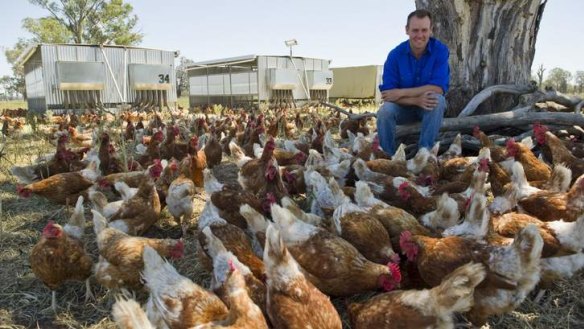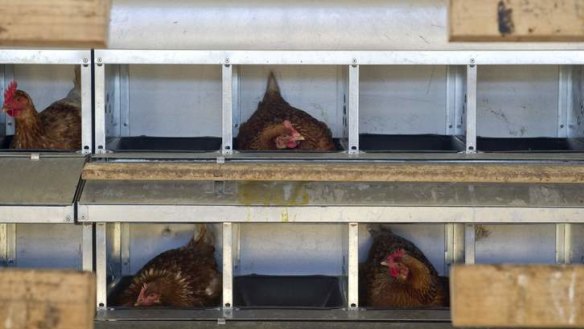New-age beef graziers: The chook farmer
Australia’s cattle pioneers became known as kings in grass castles. But farming today has become more challenging than feeding livestock, thanks to the dominance of supermarkets and multi-nationals. In a two-part article, <b>John Thistleton</b> meets the next generation who need to diversify. Here, in part one, Sam Pincott reveals how his "paddock" range eggs keeps him on the land.

Using 50 chooks instead of a tractor, diesel fuel, chemicals and fertilisers to improve soil more than surprised Sam Pincott, it changed his cattle farm.
He and wife Prue bought 50 Isa Brown hens to follow their cattle around their paddocks at Holbrook, south of Canberra, to scratch, aerate and fertilise the soil rather than use traditional tillage.
They converted a caravan for the chooks to roost in, and to store their feed. The van also became a collection point for eggs, which were left for sale on the counter of a Holbrook butcher.

''The instant feedback on the quality of those eggs astounded us,'' Pincott says. ''Having grown up with fresh farm eggs, we were getting feedback from farmers in the same situation, amazed at the quality and taste of our eggs.''
He puts this down to the chooks having a choice of grass, bugs, grubs and pellets. ''It snowballed. We realised we needed more chooks to get the benefit for the soil, and we always knew the chooks would produce the eggs, but we had under-estimated that part of the chain.
''Quickly we sat back and did the numbers, and discovered we could make a better return from eggs than cattle.'' He estimates the difference is 200 per cent. They are still grazing cattle on agistment.
We believe we are better than the legal free-range definition and that's why we are trying to call ourselves paddock range.
''We need cattle in front of chooks to eat the grass down, and the chooks come
in and do their process. Between the cattle and chooks we are growing more grass in the natural environment.''
Ryegrass and clover mats the ground and is designed to capture every drop of rainfall.
If left alone, the chooks will eat the cover through to bare earth, causing erosion. "They are so destructive, we must keep them moving,'' Pincott says.
He says paddock hens produce better eggs than free-range chooks. He's critical of the lack of a definition for free-range, which could mean anything up to 20,000 birds a hectare, and birds locked up at night and in dirt pens during the day.
''We believe we are better than the legal free-range definition and that's why we are trying to call ourselves paddock range. We run 800 birds to the hectare. The icing on the cake for me is that environment is replaced every week. So while they have ample room to spread their wings and roam in the true sense, the fact that environment is replaced every week doesn't make density any less significant, but changes emphasis.''
The eggs are richly coloured and shells strong. Colours can vary in a carton, because one chook's diet differs from another. Colours change with the season, as does their feed.
The Pincotts have outlets in supermarkets and shops in Wagga, a market in Canberra and distribute to Sydney and Melbourne.
Their most inquisitive customers are at the Exhibition Park farmer's markets, who ask what's in the pellets, how many chooks are run to the hectare and whether the birds are locked up and de-beaked.
They're not de-beaked. They're locked up briefly once a week, when their roosting pens are put on wheels and moved to a fresh, grassy part of the paddock.
Holding 400 chooks, each of the 16 sheds has a 1000-litre water tank on one end, gravity fed drippers running the length of the interior and pipes of pellets inside and out. Designed for maximum air-flow, they sprout awnings in summer and solar panels in winter to boost the lighting.
Permanent lanes will soon be established in the paddocks to save re-erecting an electric fence with each move. Four maremma dogs guard the flock. "We wouldn't be in business without them,'' Pincott says.
The business has been growing steadily since 2011. From a flock of 5500 hens they collect about 4500 eggs daily, which sell on average for $7 a dozen.
As well as the Pincotts, there are 1.5 permanent jobs and three casuals in the packing shed.
Their shed sits on the edge of Australia's busiest road-freight corridor, yet this has not delivered the distribution advantage you would expect. Pincott says, ''I see all these trucks going past every day and you think, 'if you could only pull in and stop'.''
But the big freighters are only interested in depot-to-depot delivery, so the egg farmers rely on a courier from Tumut.
Article two: The butcher
>> John Thistleton is a staff writer.
Restaurant reviews, news and the hottest openings served to your inbox.
Sign up